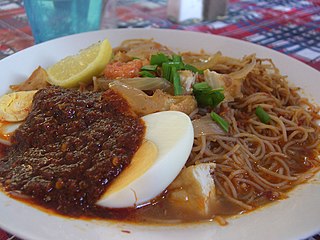
Thai cuisine is the national cuisine of Thailand.

Fried rice is a dish of cooked rice that has been stir-fried in a wok or a frying pan and is usually mixed with other ingredients such as eggs, vegetables, seafood, or meat. It is often eaten by itself or as an accompaniment to another dish. Fried rice is a popular component of East Asian, Southeast Asian and certain South Asian cuisines, as well as a staple national dish of Indonesia. As a homemade dish, fried rice is typically made with ingredients left over from other dishes, leading to countless variations. Fried rice first developed during the Sui dynasty in China.

Kuyteav is a Cambodian noodle soup consisting of rice noodles with pork stock and toppings. It is a popular breakfast dish across all of Cambodia. The kuyteav can be found at marketplace stalls, roadside vendors, restaurants and in shophouses across the country, and is distinguished by its clear broth and array of herbs, aromatics and other garnishes and condiments.

Singaporean cuisine is derived from several ethnic groups in Singapore and has developed through centuries of political, economic, and social changes in the cosmopolitan city-state.

Mee siam is a dish of thin rice vermicelli of hot, sweet and sour flavours, originated in Penang but popular among the Malay and Peranakan communities throughout Peninsular Malaysia and Singapore, although the dish is called "Siamese noodle" in Malay and thus appears to be inspired or adapted from Thai flavours when Thailand was formerly known as Siam. Mee siam is related to kerabu bee hoon although there is a significant difference in the recipe.

Noodle soup refers to a variety of soups with noodles and other ingredients served in a light broth. Noodle soup is a common dish across East Asia, Southeast Asia and the Himalayan states of South Asia. Various types of noodles are used, such as rice noodles, wheat noodles and egg noodles.

Chinese Indonesian cuisine is characterized by the mixture of Chinese with local Indonesian style. Chinese Indonesians, mostly descendant of Han ethnic Hokkien and Hakka speakers, brought their legacy of Chinese cuisine, and modified some of the dishes with the addition of Indonesian ingredients, such as kecap manis, palm sugar, peanut sauce, chili, santan and local spices to form a hybrid Chinese-Indonesian cuisine. Some of the dishes and cakes share the same style as in Malaysia and Singapore, known as Nyonya cuisine by the Peranakan.

Rice vermicelli is a thin form of noodle. It is sometimes referred to as "rice noodles" or "rice sticks", but should not be confused with cellophane noodles, a different Asian type of vermicelli made from mung bean starch or rice starch rather than rice grains themselves.

Fried noodles are common throughout East Asia, Southeast Asia and South Asia. Many varieties, cooking styles, and ingredients exist.

Shahe fen (沙河粉), or hor fun / he fen (河粉), is a type of wide Chinese noodle made from rice. Its Minnan Chinese name, 粿條, is adapted into alternate names which are widely encountered in Southeast Asia, such as kway teow, kwetiau, and kuetiau; Thai: ก๋วยเตี๋ยว (kuaitiao). Shahe fen is often stir-fried with meat and/or vegetables in a dish called chao fen. While chao fen is a transliteration of Mandarin, chow fun from Cantonese is the name most often given to the dish in Chinese restaurants in North America.

Rice noodles are noodles made with rice flour and water as the principal ingredients. Sometimes ingredients such as tapioca or corn starch are added in order to improve the transparency or increase the gelatinous and chewy texture of the noodles. Rice noodles are most common in the cuisines of China, India and Southeast Asia. They are available fresh, frozen, or dried, in various shapes, thicknesses and textures. Fresh noodles are also highly perishable; their shelf life may be just several days.

Pad see ew is a stir-fried noodle dish that is commonly eaten in Thailand. It can be found easily among street food vendors and is also quite popular in Thai restaurants around the world. The origins of the dish can be traced to China, from where the noodle stir-frying technique was brought.

Drunken noodles or drunkard noodles is a Thai stir-fried noodle dish similar to phat si-io but spicier. In English texts, it is rendered as pad kee mao, pad ki mao, or pad kimao – from its Thai name Thai: ผัดขี้เมา, RTGS: phat khi mao,, in which phat means 'to stir-fry' and khi mao means 'drunkard'.

Thai curry is a dish in Thai cuisine made from curry paste, coconut milk or water, meat, seafood, vegetables or fruit, and herbs. Curries in Thailand mainly differ from the curries in India in their use of ingredients such as fresh rhizomes, herbs, and aromatic leaves rather then a mix of dried spices.

Thai fried rice is a variety of fried rice typical of central Thai cuisine. In Thai, khao means "rice" and phat means "of or relating to being stir-fried."

Char kway teow is a stir-fried rice noodle dish from Maritime Southeast Asia of southern Chinese origin. In Hokkien and Teochew, char means 'stir-fried' and kway teow refers to flat rice noodles. It is made from flat rice noodles or kway teow of approximately 1 cm or about 0.5 cm in width, stir-fried over very high heat with garlic, light and dark soy sauce, chili paste, whole prawns, shelled blood cockles, chopped Chinese chives, slices of Chinese sausage, and bean sprouts. Other common ingredients include fishcake and belachan.

Phuket cuisine originates from Phuket, Thailand and has Chinese, Malaysian, and Thai influences.

Phat kaphrao, also spelled pad kaprow, pad kaprao, or pad gaprao, is one of the most popular Thai dishes in Thailand. This dish has garnered a reputation for its appetising appearance and flavour.

Indonesian noodles are a significant aspect of Indonesian cuisine which is itself very diverse. Indonesian cuisine recognizes many types of noodles, with each region of the country often developing its own distinct recipes.





















